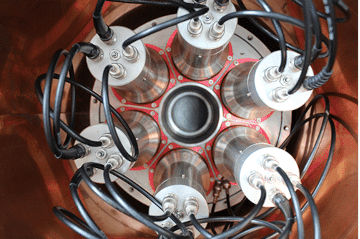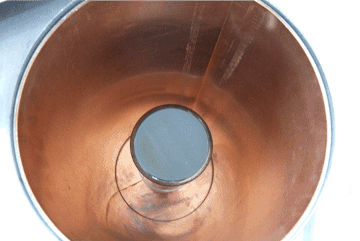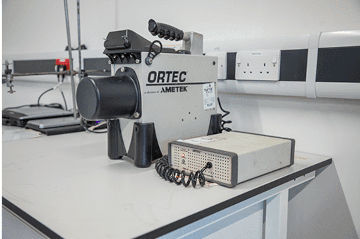RADLab
The Radiological Assay and Detection Lab (RADLab) is a radiation laboratory that specialises in advanced radiometric diagnostics using gamma-ray and neutron detectors.
Overview
The RADLab’s radiometric systems include static and portable High Purity Germanium (HPGe) detectors, Diamond detectors, and Thermoluminescent Dosimeter (TLD) reading capabilities.
Based within a leading fusion research facility, we are dedicated to delivering high-precision radiometric measurement services and pioneering diagnostic solutions that support the development, optimization, and safety of fusion energy systems.
Our mission is to empower the global fusion community with reliable, data-driven insights that accelerate the path to sustainable, clean energy.

Capabilities
Our operations are built upon five core pillars that define our approach and drive our impact:
- waste assay services
- research support services (measurements supporting both internal and external fusion-based research programmes)
- experimental benchmarking of neutronics codes
- neutron diagnostics research and development
- gamma diagnostics research and development
The RADLab’s radiometric systems include static and portable High Purity Germanium (HPGe) detectors, diamond detectors, and Thermoluminescent Dosimeter (TLD) reading capabilities. These systems assist the RADLab team in providing measurement services and training opportunities for universities, training providers, and industry.
ADRIANA
The RADLab houses the UKAEA part of the Advanced Digital Radiometric Instrumentation for Applied Nuclear Activities (ADRIANA).
ADRIANA, combining facilities at UKAEA, Lancaster University and the University of Liverpool, is a suite of digital radiometric instrumentation that forms part of the National Nuclear User Facility (NNUF).
In addition, the RADLab maintains instrumentation for high resolution gamma spectroscopy with Compton suppression and cosmic veto, real-time fast and thermal neutron spectrometry, and low dose monitoring, as well as a growing capability to custom-build electronics.
Access RADLab
Users can access the RADLab facilities in a number of ways:
- hands-on training and experience with all or a selection of the equipment
- access to the equipment for taking measurements
- loan of the equipment
- dedicated UKAEA resource to take measurements on your behalf
Contact RADLab team
The sample acceptance criteria for the RADLab are as follows:
- Dose Rate: 0 µSv/hr to 123 µSv/hr contact
- Contamination: Low or in sealed container
If you are interested in accessing the lab, please contact our team.
Instrument specification
Diamond detectors (B7, B7HT and B6HT)
- high temperature fast and thermal neutron detectors with electronics
- optimised for hot environments and confined spaces
- maximum operating temperature 200°C
- H7-HT radiation hardness 1MGy
3500 TLD Reader and TLD-3 Annealing Oven
- multiple programmable linear heating cycles
- 30 second cycle time per detector
- heating temperature capability up to 400°C
- measurement range – 10 µGy to 1 Gy
High-purity germanium detectors
 BEGe detector with Nal Compton Suppression
BEGe detector with Nal Compton Suppression
- full LabSOCS characterisation
- energy range from 3 keV to 3 MeV
- detection efficiencies and energy resolution optimised in the 3 keV to 662 keV energy region
- cooled with LN2 using a cryo-cycler
- samples must be less than the cavity diameter of 9 cm.
- optional hardware for Compton Suppression (ring of NaI detectors)
- housed in a lead castle for low background measurements
Model: BE3825
Typical Rel. Co60 Eff. (%): 26
FWHM at 5.9 keV: 0.34
FWHM at 122 keV: 0.58
FWHM at 1332 keV: 1.69
190% RE
- PROFILE MX-Series GEM P-type detector
- characterised MCNP model and Ortec ISOTOPIC modelling capability
- listmode readout data format
 190% RE coaxial HPGe detector
190% RE coaxial HPGe detector
Model: GEM-MX94100
Typical Rel. Co60 Eff. (%): 175
FWHM at 122 keV: 1.30
FWHM at 1332 keV: 2.30
Transpec
- characterised MCNP model and Ortec ISOTOPIC modelling capability
- portable:
- easy for one person to carry, lead collar lifting/carrying equipment included
- trolley for easy manoeuvring
- electrically cooled using a Stirling-cycle cooler
- large items can be measured (e.g. waste drums, pipes, etc.)
 Trans-SPEC Portable HPGe system
Trans-SPEC Portable HPGe system
Model: Trans-SPEC-DX-100T
Typical Rel. Co60 Eff. (%): 55
FWHM at 122 keV: 1.57
FWHM at 1332 keV: 2.37
Cu Cap
- Ortec ISOTOPIC modelling capability
- housed in a lead castle for low background measurements
Model: GEM35P4-PLB
Typical Rel. Co60 Eff. (%): 38
FWHM at 122 keV: 0.71
FWHM at 1332 keV: 1.7
IDM
- Ortec ISOTOPIC modelling capability
- portable:
- equipped with internal battery and line power
- easy for one person to carry, lead collar lifting/carrying equipment included
- trolley for easy manoeuvring
- electrically cooled using a Stirling-cycle cooler
- large items can be measured (e.g. waste drums, pipes, etc.)
Model: IDM-200-V
Typical Rel. Co60 Eff. (%): 54
FWHM at 122 keV: 1.17
FWHM at 1332 keV: 2.11